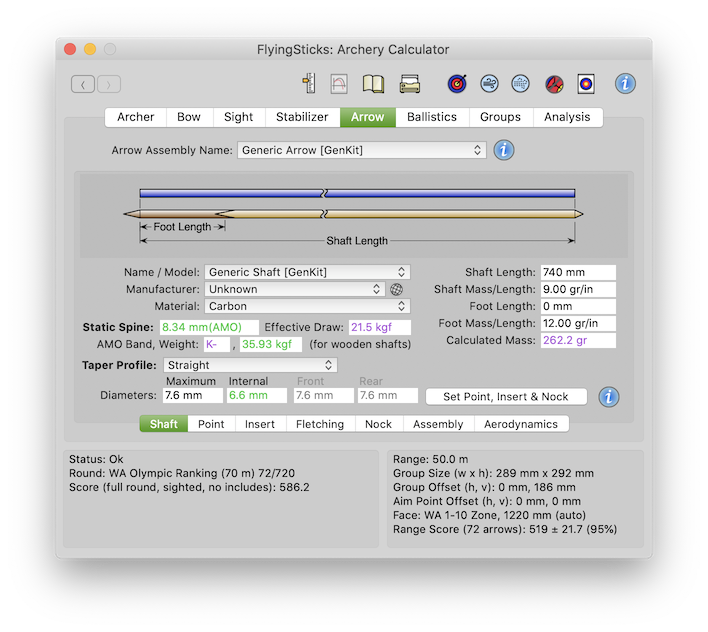Shaft name by which this shaft is identified in the database. For more details about the menu options use the Arrow Assembly Name info button above.

Optional manufacturer's name. May be used in future updates to reduce data input.

Go to manufacturer's web site if you are connected to the internet. Will open in the default browser.
Select the shaft's construction material from the drop-down menu. Used for selecting some defaults such as wall thickness, moment of inertia and dampening.
When the shaft material selection is changed, the external and internal diameters may also be changed to reflect typical values.
Enter the deflection of the shaft deflection under the load applied by the spine measurement standard. Lower the value the stiffer the shaft. By default, the units assume the ASTM measurement standard, however you may select the AMO standard by changing the units to one appended with "(AMO)". When shown with units of "ASTM" or "AMO" the actual length units are thousandths of an inch, which is often the number printed on the shaft.
This is the bow draw weight for the initial selection of an arrow shaft from the manufacturer's selection table. It converts a compound bow's draw weight to an equivalent recurve draw from an arrow's perspective and produces similar results to Carbon Express's "Bow Draw Weight, Adjusted Weight Chart" worksheet. Uses the current kit's arrow and bow data.
Select the longitudinal profile of the shaft. The front and rear shaft diameters are used to assist in evaluating the drag on the arrow and for penetration of hunting arrows.
If the shaft is barrelled, the aerodynamic model assumes the shaft's maximum diameter is about 40% back from the point. The default barrelling is 1 mm.
If a taper is selected, then it defaults to 2 mm. The defaults can be changed manually using the diameter fields.
Enter the shaft's maximum diameter. Used for aerodynamic calculations - particularly for drag and lift for the external ballistics. Will change internal diameter also.
World Archery stipulates a maximum diameter of shaft and point of 9.4 mm.
Enter the shaft's internal diameter. Used for arrow spin and buoyancy calculations. Not presently a vital parameter. Automatically adjusted if external diameter changed i.e. assumes wall thickness remains the same. Thus it is better to set external diameter before internal diameter. Set to zero for wooden shafts
For barrelled shafts enter the shaft's front and rear diameters. The upper limits are dependent on the Profile setting and current values of the other diameters. Used for aerodynamic calculations - particularly for drag and lift for the external ballistics. Fields are disabled if "Barrelled or Tapered" is left unchecked.
World Archery stipulates a maximum diameter of shaft and point of 9.4 mm.
This button will ensure the point, insert and nock diameters are set to match the shaft's diameters.
Enter the shaft's raw length i.e. excluding point, insert and nock. In the case of footed shafts include the foot length.
Enter the mass per unit of length, usually in grains per inch (gr/in) but may also be in grams per meter (g/m). Used for calculating shaft mass and FoC.
The foot is typically only found on traditional wooden arrows. Enter the foot length (defaults to zero) if present. Where the foot is spliced to the shaft, the length is taken from the mid-point of the splice.
For high performance hunting arrows, non-wood arrows may include an internal footer to move the FoC forward and to increase the structural integrity of the arrow. Good designs will avoid stress points by graduating the strengthening material. Presently FlyingSticks has no way of expressing such designs.
The foot length facility provides a means for loading distributed mass at the front of an arrow for FoC purposes. Adding mass in the form of a metal rod at the front of an arrow is a simple means for customizing clout arrows. For example if 150 mm of 2.4 mm tungsten rod is added, the footer would be define as 150 mm and the foot's mass per length would be the main shaft's plus 48.9 gr/in plus an allowance for any adhesive.
The foot is usually of denser material than the main shaft. Enter the mass per unit of length. Used for calculating shaft mass, CoG and FoC.
The calculated shaft mass - the sum of the shaft and foot masses.
Fine detail: voids within the shaft and foot usually contain the immersion fluid - air. This air has mass - typically about 0.3 grains or 0.1% of total arrow mass in a standard atmosphere. This is on the threshold of significance, however if the air pressure were higher (as on Venus!) then this would become significant. Similar, a fishing arrow can exhibit buoyancy. The Calculated Shaft Mass excludes this mass, but it is included in the Calculated Arrow Mass.